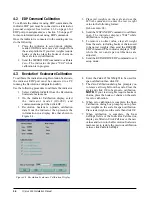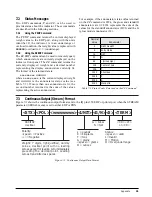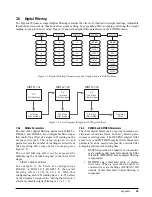
32
IQ plus 350 Installation Manual
6.0
Print Formatting
The IQ plus 350 provides two print formats, GFMT
and NFMT, that determine the format of the printed
output when the
key is pressed or when a
KPRINT EDP command is received. If the indicator is
in gross mode, the GFMT print format is used; if in
net mode, NFMT is used.
Each print format can be customized to include up to
300 characters of information, such as company name
and address, on printed tickets. You can use the
i n d i c a t o r f r o n t p a n e l ( P F O R M T m e n u ) , E D P
c o m m a n d s , o r t h e R e v o l u t i o n
™
S c a l e w a r e
configuration utility to customize the print formats.
6.1
Print Formatting Commands
Table 6-1 lists commands you can use to format the
gross and net print formats. Commands included in
the format strings must be enclosed between < and >
delimiters. Any characters outside of the delimiters
are printed as text on the ticket. Text characters can
include any ASCII character that can be printed by the
output device.
The default GFMT and NFMT print formats use only
the new line (<NL>) command and the commands for
gross, net, and tare weights in displayed units (<G>,
<N>, and <T>).
The default IQ plus 350 print formats are shown in
Table 6-2:
NOTES:
•
The <G2>, <N2>, and <T2> commands listed
in Table 6-1 print the gross, net, and tare
weights in non-displayed units—that is, in the
units not currently displayed on the indicator.
•
ID numbers included in the print format string
(<ID> command) must be set using the
KNEWID EDP command.
•
The 300-character limit of each print format
string includes the output field length of the
print formatting commands, not the command
length. For example, if the indicator is
configured to show a decimal point, the <G>
command generates an output field of 13
characters: the 10-character weight value
(including decimal point), one space, and a
two-digit units identifier.
6.2
Customizing Print Formats
The following sections describe procedures for
customizing the GFMT and NFMT formats using the
EDP port, the front panel (PFORMT menu), and the
Revolution Scaleware configuration utility.
6.2.1
Using the EDP Port
With a personal computer, terminal, or remote
keyboard attached to the IQ plus 350 EDP port, you
can use the EDP command set to customize the print
format strings.
To view the current setting of a format string, type the
name of the string (GFMT or NFMT) and press
E N T E R
. F o r e x a m p l e , t o c h e c k t h e c u r r e n t
configuration of the GFMT format, type GFMT and
press
ENTER
. The indicator responds by sending the
current configuration for the gross format:
GFMT=<G> GROSS<NL>
Command
Description
<G>
Gross weight in displayed units
<G2>
Gross weight in non-displayed units
<N>
Net weight in displayed units
<N2>
Net weight in non-displayed units
<T>
Tare weight in displayed units
<T2>
Tare weight in non-displayed units
<ID>
ID number
<CN>
Consecutive number
<NL
nn>
New line (
nn
= number of termination (<CR/LF>
or <CR>) characters)*
<SP
nn>
Space (
nn
= number of spaces)*
<SU>
Toggle weight data format (formatted/
unformatted)**
Gross, net, and tare weights are 9 digits in length, including
sign (10 digits with decimal point), followed by a space and
a two-digit units identifier. Total field length with units
identifier is 12 (or 13) characters.
ID and consecutive number (CN) fields are 1–6 characters in
length, as required.
* If
nn
is not specified, 1 is assumed. Value must be in the
range 1–99.
** After receiving an SU command, the indicator sends
unformatted data until the next SU command is received.
Unformatted data omits decimal points, leading and trailing
characters.
Table 6-1. Print Format Commands
Format
Default Format String
Sample Output
GFMT
<G> GROSS<NL>
2046.81 LB GROSS
NFMT
<G> GROSS<NL>
<T> TARE<NL>
<N> NET<NL>
4053.1 LB GROSS
15.6 LB TARE
4037.5 LB NET
Table 6-2. GFMT and NFMT Formats
Содержание IQ plus 350
Страница 1: ...43544 IQ plus 350 Digital Weight Indicator Version 1 0 Installation Manual ...
Страница 2: ......



























